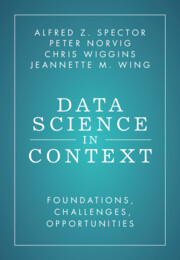Book contents
- Data Science in Context
- Reviews
- Data Science in Context
- Copyright page
- Contents
- Figures
- Tables
- Preface
- Acknowledgments
- Introduction
- Part I Data Science
- Chapter 1 Foundations of Data Science
- Chapter 2 Data Science Is Transdisciplinary
- Chapter 3 A Framework for Ethical Considerations
- Recap of Part I: Data Science
- Part II Applying Data Science
- Part III Challenges in Applying Data Science
- Part IV Addressing Concerns
- Chapter 20 Concluding Thoughts
- Appendix Summary of Recommendations from Part IV
- About the Authors
- References
- Index
Chapter 1 - Foundations of Data Science
from Part I - Data Science
Published online by Cambridge University Press: 29 September 2022
- Data Science in Context
- Reviews
- Data Science in Context
- Copyright page
- Contents
- Figures
- Tables
- Preface
- Acknowledgments
- Introduction
- Part I Data Science
- Chapter 1 Foundations of Data Science
- Chapter 2 Data Science Is Transdisciplinary
- Chapter 3 A Framework for Ethical Considerations
- Recap of Part I: Data Science
- Part II Applying Data Science
- Part III Challenges in Applying Data Science
- Part IV Addressing Concerns
- Chapter 20 Concluding Thoughts
- Appendix Summary of Recommendations from Part IV
- About the Authors
- References
- Index
Summary
This chapter first defines data science, its primary objectives, and several related terms. It continues by describing the evolution of data science from the fields of statistics, operations research, and computing. The chapter concludes with historical notes on the emergence of data science and related topics.
Information
- Type
- Chapter
- Information
- Data Science in ContextFoundations, Challenges, Opportunities, pp. 7 - 28Publisher: Cambridge University PressPrint publication year: 2022
